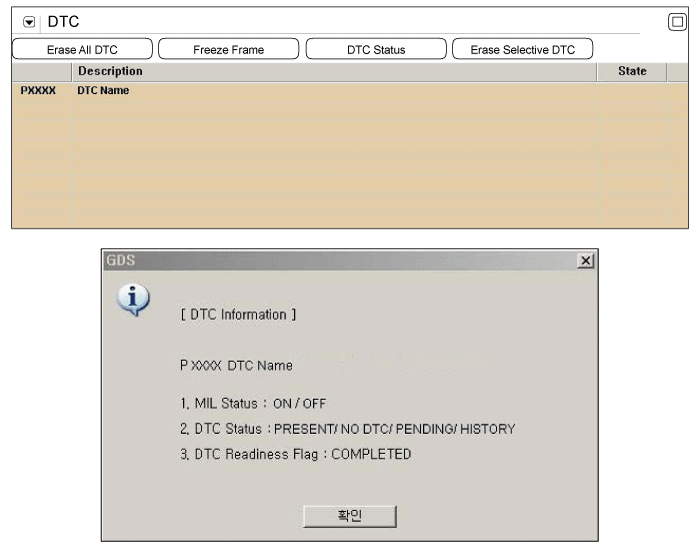
The Crankshaft Position
Sensor (CKPS) is a magnetic field sensitive type sensor that generates
voltage using a sensor and a target wheel mounted on the crankshaft; there
are 58 slots in the target wheel where one is longer than the
others.
During one crankshaft
rotation there are 58 rectangular signals and one longer signal. The PCM
calculates engine RPM by using the sensor's signal and controls the
injection duration and the ignition timing. Using the signal differences
caused by the longer slot, the PCM identifies which cylinder is at top
dead center.
Checking reference
signals from CKPS under detecting condition, if any signal is not detected
for more than 0.15 sec., PCM sets P0335. MIL(Malfunction Indication Lamp)
turns on when the malfunction lasts till consecutive 2 driving
cycle.
Item
|
Detecting
Condition
|
Possible cause
|
DTC
Strategy
|
| •
|
Check reference wave during
cranking | |
|
Enable
Conditions
|
| •
|
IG "ON", Cranking or engine-off during
driving |
| •
|
Camshaft positon sensor state
change | |
Threshold
value
|
| •
|
No reference signal over 0.15
sec. | |
Diagnosis
Time
|
|
MIL On
Condition
|
|


| 1. |
Check DTC Status
| (1) |
Connect scantool to Data Link
Connector(DLC). |
| (3) |
Select "DTC" button, and then Press "DTC
Status" to check DTC's information from the DTCs
menu. |
| (4) |
Read "DTC Status"
parameter.

|
| (5) |
Is parameter displayed "Present
fault"?
|

|
▶ Go
to "Terminal and connector inspection"
procedure.
|
|

|
▶
Fault is intermittent caused by poor contact in the
sensor's and/or PCM's connector or was repaired and PCM
memory was not cleared. Thoroughly check connectors for
looseness, poor connection, ending, corrosion,
contamination, deterioration, or damage. Repair or
replace as necessary and go to "Verification of Vehicle
Repair"
procedure.
|
| |
| Terminal And Connector
Inspection |
| 1. |
Many malfunctions in the electrical system are
caused by poor harness and terminal condition. Faults can also be
caused by interference from other electrical systems, and mechanical
or chemical damage. |
| 2. |
Thoroughly check connectors for looseness,
poor connection, bending, corrosion, contamination, deterioration,
or damage. |
| 3. |
Has a problem been found?
|

|
▶ Repair as
necessary and go to "Verification of Vehicle Repair"
procedure
|
|

|
▶ Go to
"Signal Circuit Inspection"
procedure.
|
|
| Signal Circuit
Inspection |
■ Check voltage
| 1. |
IG "OFF" and disconnect CKPS
connector. |
| 3. |
Measure voltage between low signal terminal of
CKPS harness connector and chassis
ground. |
| 4. |
Measure voltage between high signal terminal
of CKPS harness connector and chassis ground.
Specification
: Approx. 1.4V
| |
| 5. |
Is the measured voltage within
specification?
|

|
▶ Go to
"Component Inspection" procedure.
|
|

|
▶ Go to
"Check open in harness" as
follows.
|
|
■ Check open in harness
| 1. |
IG "OFF" and disconnect CKPS connector and PCM
connector. |
| 2. |
Measure resistance between low signal terminal
of CKPS harness connector and CKPS low signal terminal of PCM
harness connector. |
| 3. |
Measure resistance between high signal
terminal of CKPS harness connector and CKPS high signal terminal of
PCM harness connector.
|
| 4. |
Is the measured resistance within
specification?
|

|
▶ Go to
"Component Inspection" procedure.
|
|

|
▶ Repair
open in harness, and go to "Verification of Vehicle Repair"
procedure.
|
|
■ Check CKPS
| 1. |
IG "OFF" and disconnect CKPS
connector. |
| 2. |
Measure resistance between low signal and high
signal terminals of CKPS connector.(Component side)
|
| 3. |
Is the measured resistance within
specification?
|

|
▶ Go to
"Check signal waveform of CKPS" as follows.
|
|

|
▶
Substitute with a known - good CKPS and check for proper
operation. If the problem is corrected, replace CKPS and go to
"Verification of Vehicle Repair"
procedure.
|
|
■ Check signal waveform of CKPS
| 1. |
IG "OFF" and connect
scantool. |
| 2. |
ENG "ON" and Measure signal waveform at signal
terminal of CKPS.
Reference signal
waveform :

|
| 3. |
Is the measured signal waveform
normal?
|

|
▶
Thoroughly check connectors for looseness, poor connection,
bending, corrosion, contamination, deterioration, or damage.
Repair or replace as necessary, and go to "Verification of
Vehicle Repair" procedure.
|
|

|
▶
Substitute with a known - good PCM and check for proper
operation. If the problem is corrected, replace PCM and go to
"Verification of Vehicle Repair"
procedure.
|
|
There is a memory reset function on
scantool that can erase optional parts automatically detected
and memorized by PCM. After testing PCM on the vehicle, use
this function to reuse the PCM on the
others | |
| Verification Of Vehicle
Repair |
After a repair, it is
essential to verify that the fault has been corrected.
| 1. |
Connect scantool and select "DTC"
button. |
| 2. |
Press "DTC Status" button and confirm that
"DTC Readiness Flag" indicates "Completed". If not, drive the
vehicle within conditions noted in the freeze frame data or enable
conditions |
| 3. |
Read "DTC Status"
parameter |
| 4. |
Is parameter displayed "History(Not Present)
fault"?
|

|
▶ System
performing to specification at this time. Clear the
DTC
|
|

|
▶ Go to the
applicable troubleshooting
procedure.
|
|